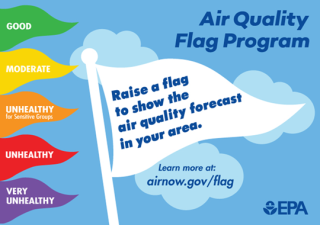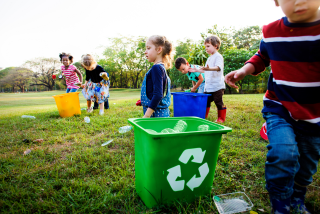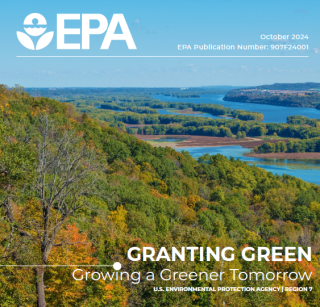Region 7 Community Information Guide
EPA Region 7’s Community Information Guide provides communities, nonprofits, stakeholder groups, community-based organizations, academia, tribes, state and local governments, and other partners with the latest information on funding and technical assistance opportunities, meetings, conferences, events, webinars, and other activities related to human health and the environment.
This guide is updated periodically, so be sure to check back for the latest information!

On this page:
- Headlines
- Funding and Technical Assistance
- Meetings, Conferences and Events
- Webinars and Conference Calls

To suggest content for this page, please send an email to: R7_Communities_Digest@epa.gov.
EPA Seeks Applications for 2025 President's Environmental Youth and Educator Awards
Exciting news! EPA’s Environmental Education and Stewardship Division has extended the deadline for applications for the 2025 President’s Environmental Youth Awards (PEYA) and Presidential Innovation Awards for Environmental Educators (PIAEE). Applications for both awards are now due no later than Friday, January 16, 2026. The EPA is focused on Powering the Great American Comeback and wants to recognize students and educators across the country who demonstrate outstanding environmental stewardship. As America celebrates 250 years of independence, EPA wants to celebrate students and teachers who are making a positive impact to promote environmental awareness to forge American greatness for the next 250 years. To do this, EPA has extended the deadline to give applicants the opportunity to utilize their winter breaks to complete and submit their applications. The 1990 National Environmental Education Act established PEYA, which recognizes outstanding environmental stewardship projects from students in Grades K-12 that protect our nation’s natural resources. The act also established PIAEE, which recognizes outstanding Grade K-12 educators who use environmental education as a learning tool to excite students and communities about protecting human health and the environment. Projects should align with only one or more of the focus areas listed below:
For PEYA, application and eligibility information is available on EPA’s PEYA web page.
For PIAEE, Application and eligibility information is available on EPA’s PIAEE web page.
|

Headlines
Relaunch of EPA’s Guidance Portal
- EPA has relaunched the EPA Guidance Portal, a streamlined website for accessing important guidance documents related to air quality, water protection, hazardous waste management, and more. The website serves as a resource for all guidance documents managed across EPA's environmental programs. It is designed to be a one-stop shop to help users and small businesses easily and quickly locate and follow EPA’s active guidance documents on topics of interest.
- EPA guidance documents inform the public how the agency interprets an underlying statute and its regulations, and take the form of memoranda, policy statements, handbooks, manuals, and other documents formally titled as guidance. Guidance documents that have been superseded with newer guidance are not included in the updated website.

- One way to get students involved in learning about outdoor air quality – and the impacts it can have on indoor air quality – is EPA's Air Quality Flag Program. This program is a simple resource for teachers and schools to keep communities informed about air quality using colorful flags based on EPA’s Air Quality Index (AQI). The program’s colorful flags reflect the daily outdoor air quality forecast – crucial information during times when smoke can significantly impact air quality and pose health risks. Raising a flag each day helps everyone make informed decisions about outdoor activities, ensuring that children can enjoy safe play while protecting their health.
- For added convenience, you can also virtually display AQI flags or install an AQI widget for timely updates on school screens. Visit the Air Quality Flag Program website at the link above to learn which flag to fly and promote a healthy learning environment for children.
Funding and Technical Assistance
Kansas State University Technical Assistance to Brownfields (KSU TAB) program
|

U.S. Department of Energy’s Tribal Energy Financing – $20 Billion
- Due date: Aug. 31, 2028
- Information: This program is supporting tribal investment in a broad range of projects and activities for the development of energy resources, products, and services that utilize commercial technology.
- Eligible entities: federally recognized Indian tribes, including Alaska Native Regional Corporations and Alaska Native Village Corporations.
EPA Emerging Contaminants (EC) in Small or Disadvantaged Communities Grant (SDC) – $2 Billion
- Due date: ongoing
- This noncompetitive program will provide states, territories, and tribes with grants to public water systems in small or disadvantaged communities to address emerging contaminants, including per- and polyfluoroalkyl substances (PFAS).
- Eligible entities: states, territories, tribes.
- Due date: ongoing
- EIR offers financing to support projects that retool, repower, repurpose, or replace energy infrastructure that has ceased operations or that enable operating energy infrastructure to avoid, reduce, utilize, or sequester air pollutants or anthropogenic emissions of greenhouse gases.
- Eligible entities: See program guidance.

- Due date: none
- The ERIF Tribal Assistance Program provides funding and support to tribal governments to enhance their participation in the federal environmental review process for infrastructure projects. The FPISC has designated $15 million from the ERIF to aid tribal governments through the program. The ERIF Tribal Assistance Program supports tribal involvement in environmental reviews for projects covered under FAST-41, providing tribes with resources to support their meaningful engagement in consultations and reviews necessary for project approvals.
- Eligible entities: federally recognized tribes.
EPA Science Matters: Wildfire Smoke and More
- Smoke from wildfires can impact air quality across much of the U.S. EPA researchers have been working to address many of the issues wildfires present to health and the environment, including preparing communities and individuals on how to protect themselves.
- Listen to EPA's Jason Sacks and a panel of other experts discuss how wildfire smoke affects your health on NPR's 1A.
- EPA's Ana Rappold spoke to The Atlantic about the effects of wildfire smoke and particulate matter on brain function.
- EPA develops software models and tools to address a range of environmental issues. The Community Multiscale Air Quality (CMAQ) modeling system is EPA’s premier tool for studying air pollution from global to local scales. In June 2023, EPA celebrated the 25th anniversary of CMAQ’s initial release with a three-part story on the history and significance of this powerful computational tool.
- Read about what has made the CMAQ model so successful over the years and why it is still relevant today.
- Read about how CMAQ has been working toward a “one environment-one health” approach throughout its lifetime.
- Read about how CMAQ has continued to innovate, modernize, and address emerging environmental issues.

Environmental Finance Center Network
- The Environmental Finance Center Network offers free help on training and technical assistance to small wastewater and decentralized wastewater treatment works serving approximately 10,000 or fewer people. Request assistance here.
U.S. Department of Energy’s National Community Solar Partnership+
U.S. Department of Energy’s Clean Cities Coalition Network Technical Assistance
- To assist with alternative fuels, fuel economy improvements, and emerging transportation technologies.
- This update includes data provided by EPA Brownfields, Superfund, Abandoned Mine Lands, Landfill Methane Outreach, and Resource Conservation and Recovery Act programs, and a pilot with Underground Storage Tanks, in addition to data from 22 state partners. Over 190,000 sites and nearly 40 million acres of land are included and screened for solar, wind, biomass and geothermal energy potential. EPA partnered with the U.S. Department of Energy’s National Renewable Energy Lab (NREL) to provide up-to-date data and screening that reflects current trends in renewable energy development.
EPA Combined Sewer Overflow (CSO) Technical Assistance
- CSO Technical Assistance is available from EPA’s Office of Wastewater Management on monitoring/modeling; smart sewers and smart data; asset management; operation and maintenance; regulatory/ compliance questions; and small CSO community spreadsheet-based tools (CSO model, long-term control plan review checklist, post-construction compliance monitoring checklist). See flyer for more information.
EPA CSO Tools Available
- Check out the NEW CSO Tools for combined sewer overflow permittees and permitting authorities for planning and management of different aspects of CSO programs. Each tool consists of an interactive spreadsheet, fact sheet or user guide, and three recorded trainings. These tools, which are currently in Beta test version, do not present new or changed requirements; rather they attempt to help break down information in a more digestible and interactive fashion.
- Long-Term Control Plan (LTCP) Review Checklist – Designed to help CSO permittees and NPDES authorities determine if LTCPs meet the requirements of the Clean Water Act (CWA) and the CSO Control Policy and conform with EPA guidance on developing LTCPs.
- Post-Construction Compliance Monitoring (PCCM) Checklist – Designed to help CSO permittees and NPDES authorities develop and evaluate PCCM programs to meet the requirements of the CWA and CSO Control Policy and conform with EPA guidance on PCCM.
- Combined Sewer Overflow (CSO) Model for Small Communities – Planning tool for small CSO communities that want a reasonably simple approach to estimating a CSO occurrence, as well as treated or untreated CSO volume over a 24-hour period and have limited resources to invest in more advanced CSO monitoring and modeling.

Meetings, Conferences and Events
No items at this time.Please check back for new webinars and conference calls. |

Webinars and Conference Calls
No items at this time.Please check back for new webinars and conference calls. |
The information above is being provided by EPA Region 7 for informational purposes only. This page contains links to information, agencies, sites, and organizations external to EPA’s website. EPA is not responsible for third-party links. EPA does not endorse third-party organizations or agencies.
Related Information

- Want to tell EPA about an environmental violation? See “Report a Violation” link at top.

